Table of Contents
Introduction
According to Rum Statistics, Rum, a distilled alcoholic drink derived from sugarcane by-products, holds a storied history dating back to the 17th century Caribbean.
Its production process involves fermentation of sugarcane by-products, distillation, aging in wooden barrels, and blending to achieve desired flavor profiles.
Varieties include light rum, known for its mild taste, and gold rum, with richer flavors. Dark rum has deep complexities; spiced rum is infused with aromatic spices, and over-proof rum boasts a higher alcohol content.
Used in cocktails, cooking, and sipping neat, rum’s versatility and diverse flavors ensure its enduring popularity worldwide, especially as demand for premium and craft rums grows.
Editor’s Choice
- The global rum market revenue is anticipated to reach USD 20.4 billion in 2028.
- The forecast for 2025 and beyond indicates a steady state, with offline sales projected to hold 97.7% of the market share and online sales expected to remain at 2.6% through 2027.
- The global rum market is characterized by a diverse range of companies, with private labels leading the market at 9%.
- The United States leads with a substantial market revenue of USD 1,549 million.
- The global rum consumption statistics for out-of-home settings are projected to reach 111.4 million liters in 2028.
- In 2022, the leading rum brands worldwide, based on sales volume, demonstrated significant market presence. Tanduay led the market with an impressive sales volume of 27.5 million 9-liter cases.
- In 2022, Italy led the global rum export market with a total export value of USD 226 million, accounting for 11.20% of the market.
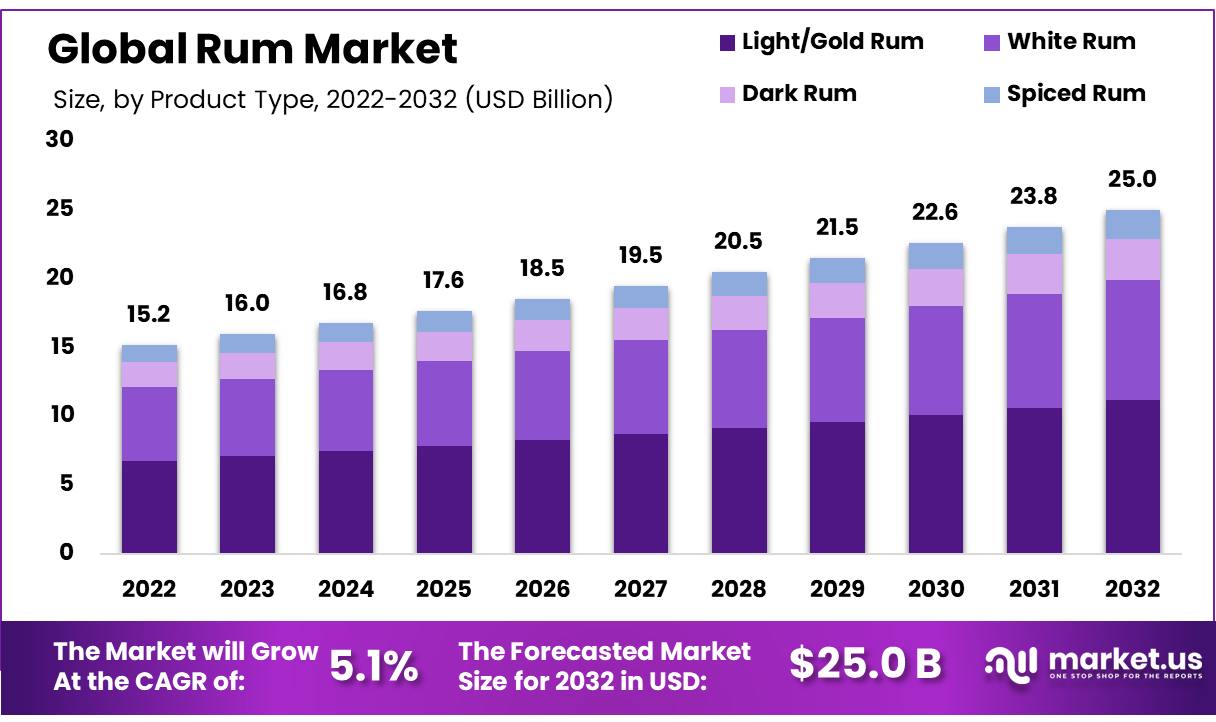
History of Rum
- The history of rum is a fascinating journey that dates back to the early 17th century, primarily originating in the Caribbean. The production of rum began on sugar plantations in the West Indies, where molasses, a by-product of sugar production, was distilled into this iconic spirit.
- By the mid-1600s, rum had become popular among sailors and pirates, who relied on it for sustenance and morale during long voyages.
- The British Navy even adopted rum as part of their sailors’ rations, a tradition that lasted until 1970.
- Rum also played a significant role in the American colonies, particularly in New England, where it was distilled locally and became central to the economy. It was a key component of the Triangular Trade, linking the colonies with the Caribbean and Africa.
- The American Revolution further cemented rum’s place in history, as it became a symbol of resistance against British taxation, leading to events like the Boston Tea Party.
- The Prohibition era in the United States (1920-1933) marked another pivotal chapter for rum. Despite the ban on alcohol, rum remained popular in underground bars and speakeasies, contributing to the creation of classic cocktails such as the Daiquiri and Mojito.
Global Rum Market Overview
Global Rum Market Size
- The global rum market has experienced fluctuations over the past several years.
- In 2018, the market revenue stood at USD 15.9 billion, slightly decreasing to USD 15.8 billion in 2019.
- A notable decline occurred in 2020, with revenue dropping to USD 13.8 billion, likely influenced by the global economic impact of the COVID-19 pandemic.
- However, the market began to recover in 2021, with revenue increasing to USD 14.4 billion.
- The upward trend is projected to persist, with the market expected to achieve USD 17.0 billion in 2024, USD 17.8 billion in 2025, USD 18.7 billion in 2026, USD 19.6 billion in 2027, and USD 20.4 billion in 2028.
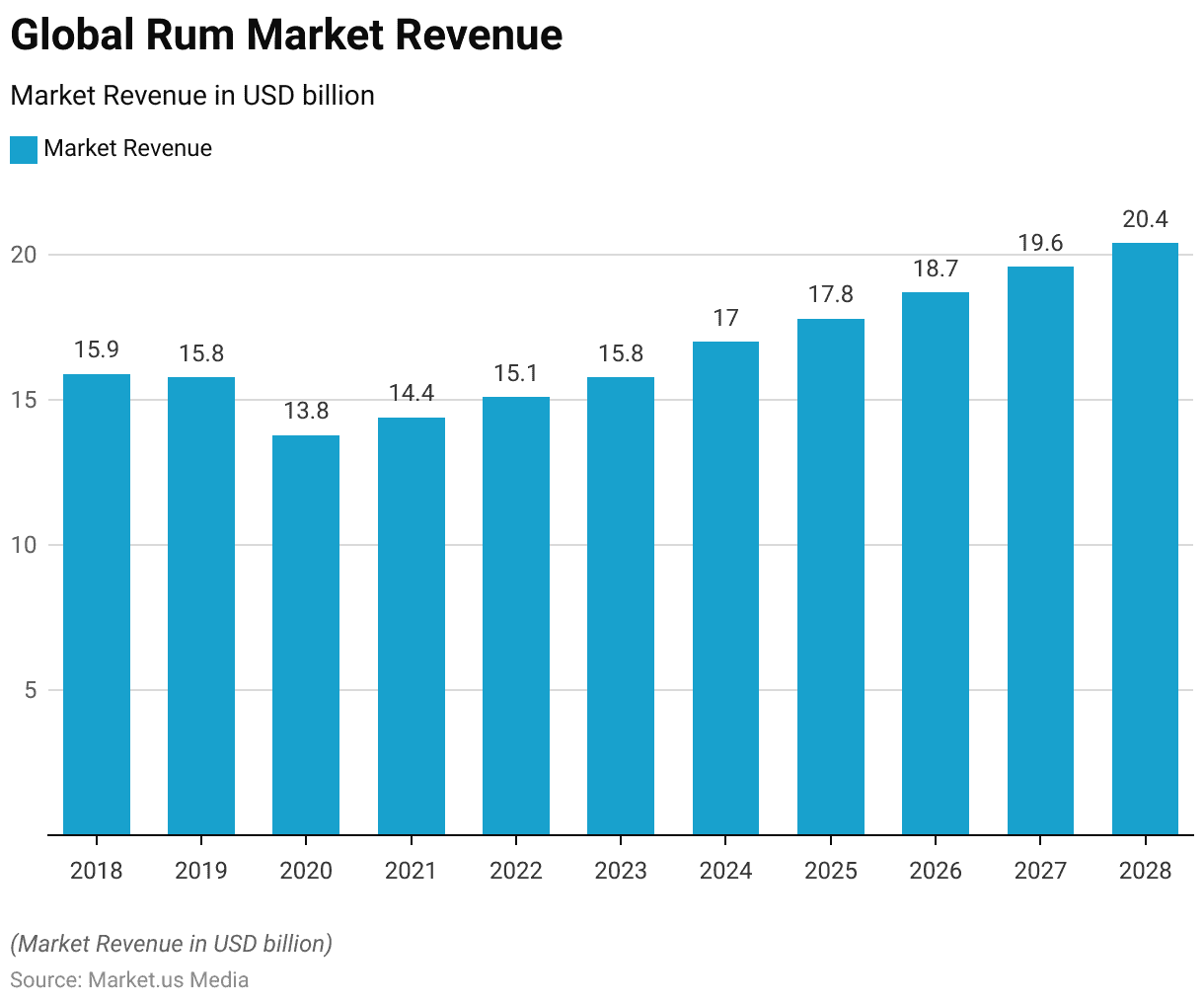
Rum Market Revenue Trends: At Home vs. Out-of-Home
- The global rum market has demonstrated varied revenue trends in recent years, with distinct differences between at-home and out-of-home consumption.
- In 2018, the total market revenue was USD 15.9 billion, with USD 10.2 billion generated from at-home sales (e.g., supermarkets and convenience stores) and USD 5.8 billion from out-of-home sales (e.g., restaurants and bars).
- In 2020, the total market revenue dropped to USD 13.8 billion, attributed to the COVID-19 pandemic, with at-home revenue remaining steady at USD 10.1 billion while out-of-home revenue fell significantly to USD 3.7 billion.
- In 2022, the total revenue rose to USD 15.1 billion, with at-home revenue at USD 10.1 billion and out-of-home revenue improving to USD 4.4 billion.
- By 2028, at-home revenue is anticipated to reach USD 13.3 billion, while out-of-home revenue is expected to grow to USD 7.1 billion.

Rum Market Share – By Sales Channel
- In 2017, offline sales accounted for 98.9% of the market share, while online sales contributed a mere 1.1%.
- A significant shift occurred in 2020 when the COVID-19 pandemic accelerated the growth of online sales, leading to a decrease in offline sales to 97.9% and an increase in online sales to 2.1%.
- In 2022, the market saw a slight correction, with offline sales increasing to 97.5% and online sales decreasing to 2.5%. This minor fluctuation continued into 2023, where offline sales accounted for 97.6% and online sales for 2.4%.
- The forecast for 2025 and beyond indicates a steady state, with offline sales projected to hold 97.7% of the market share and online sales expected to remain at 2.6% through 2027.
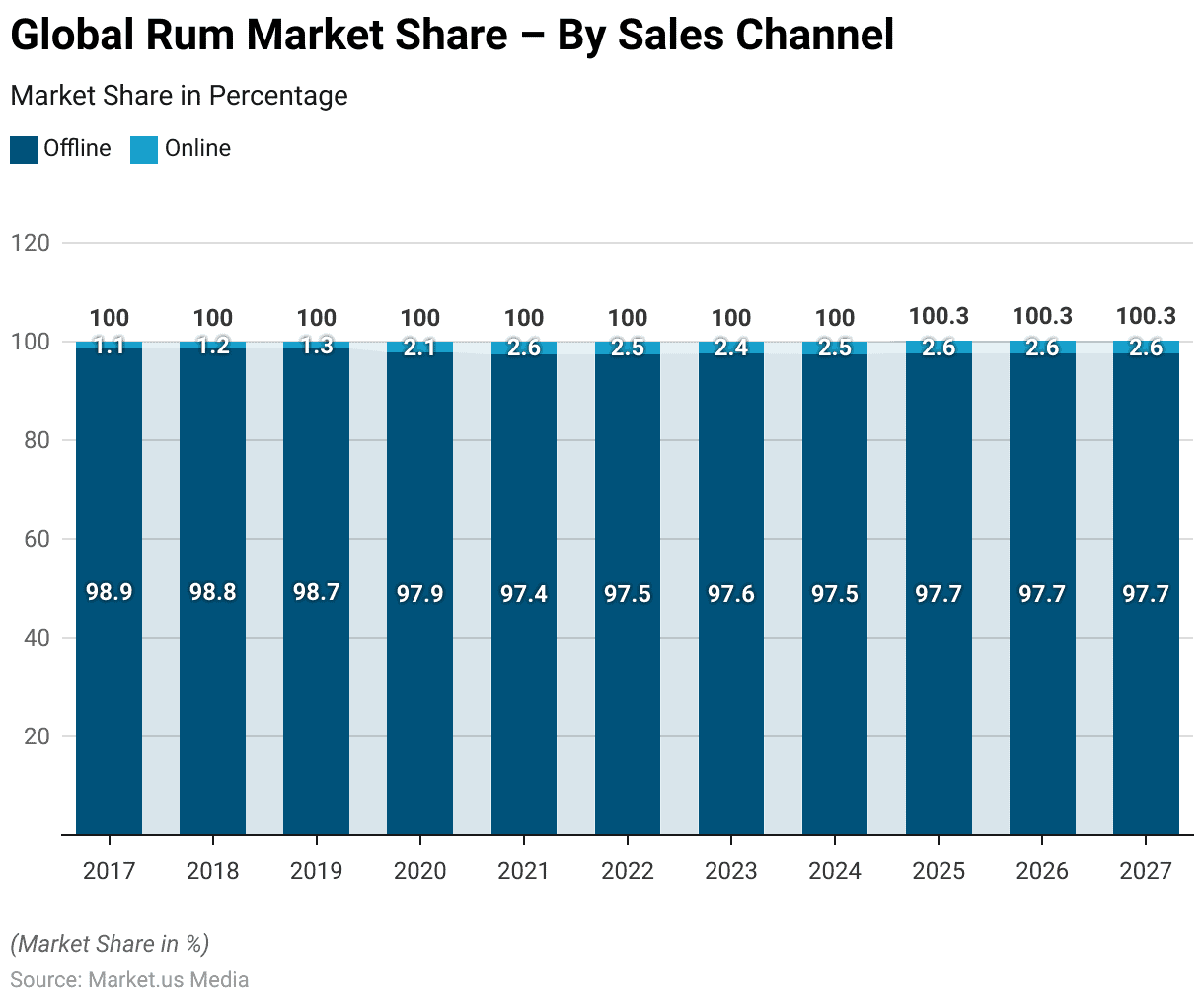
Competitive Landscape of the Global Rum Market
- The global rum market is characterized by a diverse range of companies, with a significant portion of the market share held by various brands and producers.
- Private Label leads the market with a 9% share, followed by Bacardi with 7% and Tanduay with 6%.
- Captain Morgan holds a 4% market share, while Appleton, Castillo, and Havana Club each command a 3% share.
- Barcelo and Santa Teresa each have a 2% market share, and Banks holds a 1% share.
- Notably, the remaining 60% of the market is occupied by other brands, indicating a highly fragmented industry with numerous smaller players contributing to the overall market dynamics.
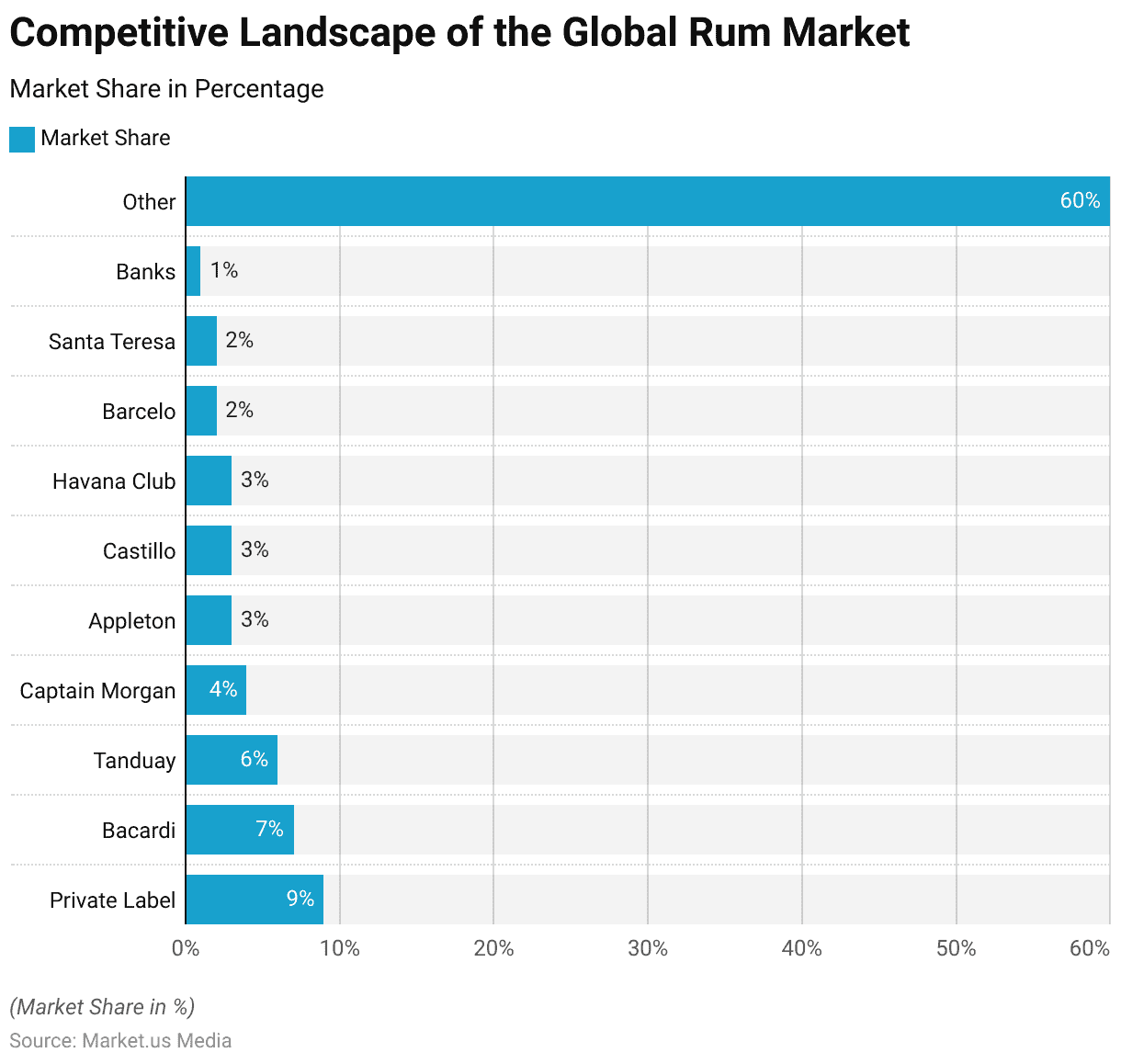
Regional Analysis of Rum Market
- The global rum market exhibits significant revenue contributions from various countries.
- The United States leads with a substantial market revenue of USD 1,549 million, followed by India, which generates USD 1,240 million.
- Germany also holds a notable position with a market revenue of USD 934 million.
- Spain and Canada contribute significantly to the market, with revenues of USD 779 million and USD 776 million, respectively.
- France follows closely with a revenue of USD 734 million.
- The United Kingdom and Brazil each have substantial market revenues, with the UK at USD 689 million and Brazil at USD 688 million.
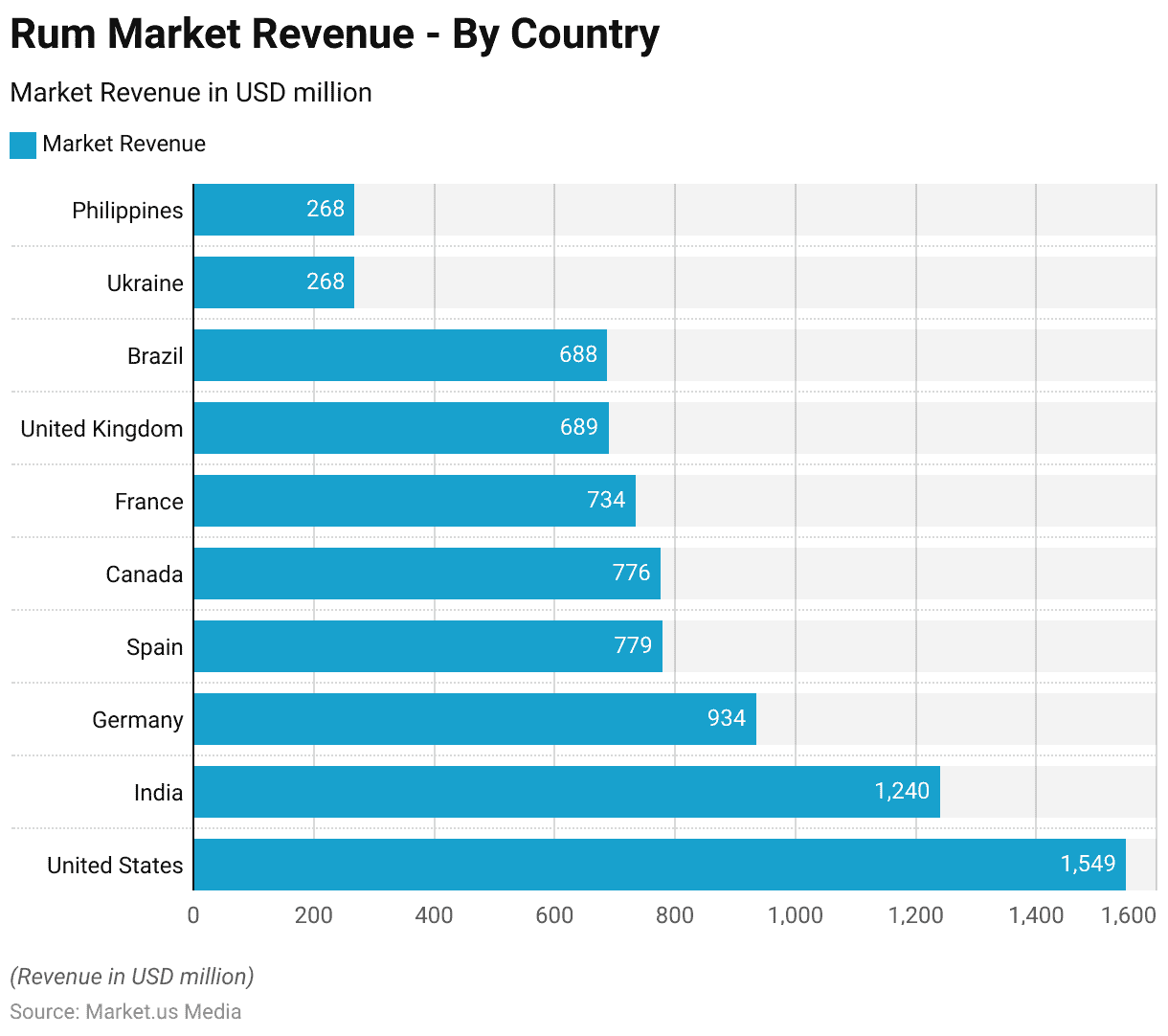
Revenue Per Capita
- The global rum market’s revenue per capita has demonstrated a fluctuating yet generally upward trend over the past several years.
- In 2018, the revenue per capita was USD 2.17, which slightly decreased to USD 2.13 in 2019.
- The year 2020 saw a more pronounced decline to USD 1.84, likely impacted by the global economic challenges of the COVID-19 pandemic.
- However, a recovery began in 2021, with revenue per capita rising to USD 1.91.
- Projections indicate sustained growth in the coming years, with revenue per capita expected to increase to USD 2.2 in 2024, USD 2.28 in 2025, USD 2.38 in 2026, USD 2.47 in 2027, and USD 2.55 in 2028.

Revenue Per Capita Out of Home
- The revenue per capita out of home for the global rum market has experienced notable changes over the years.
- In 2018, the revenue per capita out of home was USD 0.78, slightly decreasing to USD 0.77 in 2019.
- The impact of the COVID-19 pandemic in 2020 led to a significant drop, bringing the revenue down to USD 0.50, a figure that remained unchanged in 2021.
- A recovery began in 2022, with the revenue per capita increasing to USD 0.58.
- Further increases are anticipated, with projections of USD 0.86 in 2027 and USD 0.88 in 2028.
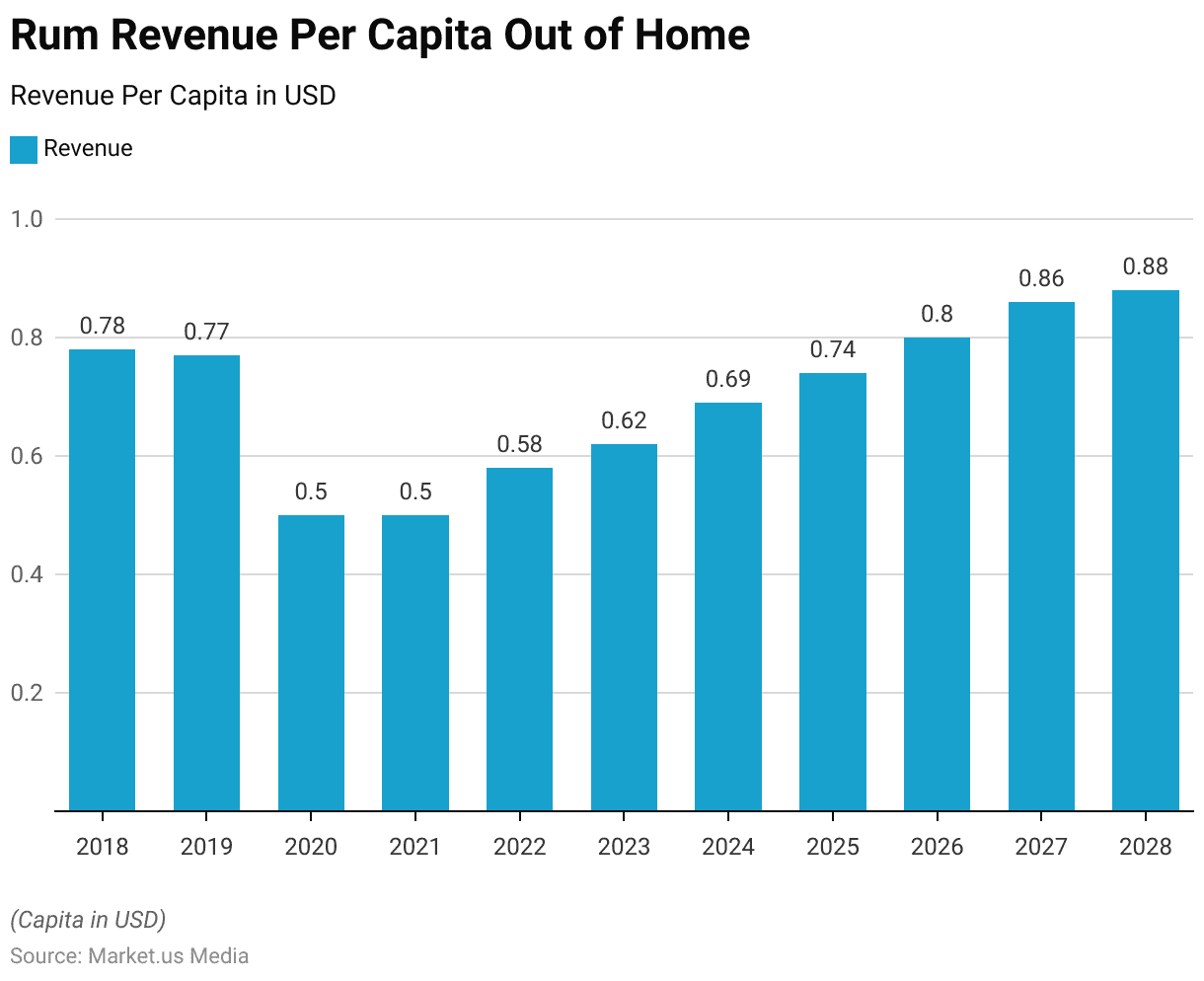
Global Rum Consumption Statistics
Rum Consumption Volume, Out-of-home
- The global rum consumption statistics for out-of-home settings have shown significant fluctuations over the past decade.
- In 2018, the volume consumed by homes was 119.7 million liters, slightly increasing to 120.3 million liters in 2019.
- The year 2020 marked a dramatic decline to 77.4 million liters, largely due to the widespread impact of the COVID-19 pandemic on social and recreational activities.
- However, recovery began in 2022, with out-of-home consumption rising to 80.7 million liters and further to 83.0 million liters in 2023.
- The growth is anticipated to continue, with volumes reaching 110.1 million liters in 2027 and 111.4 million liters in 2028.
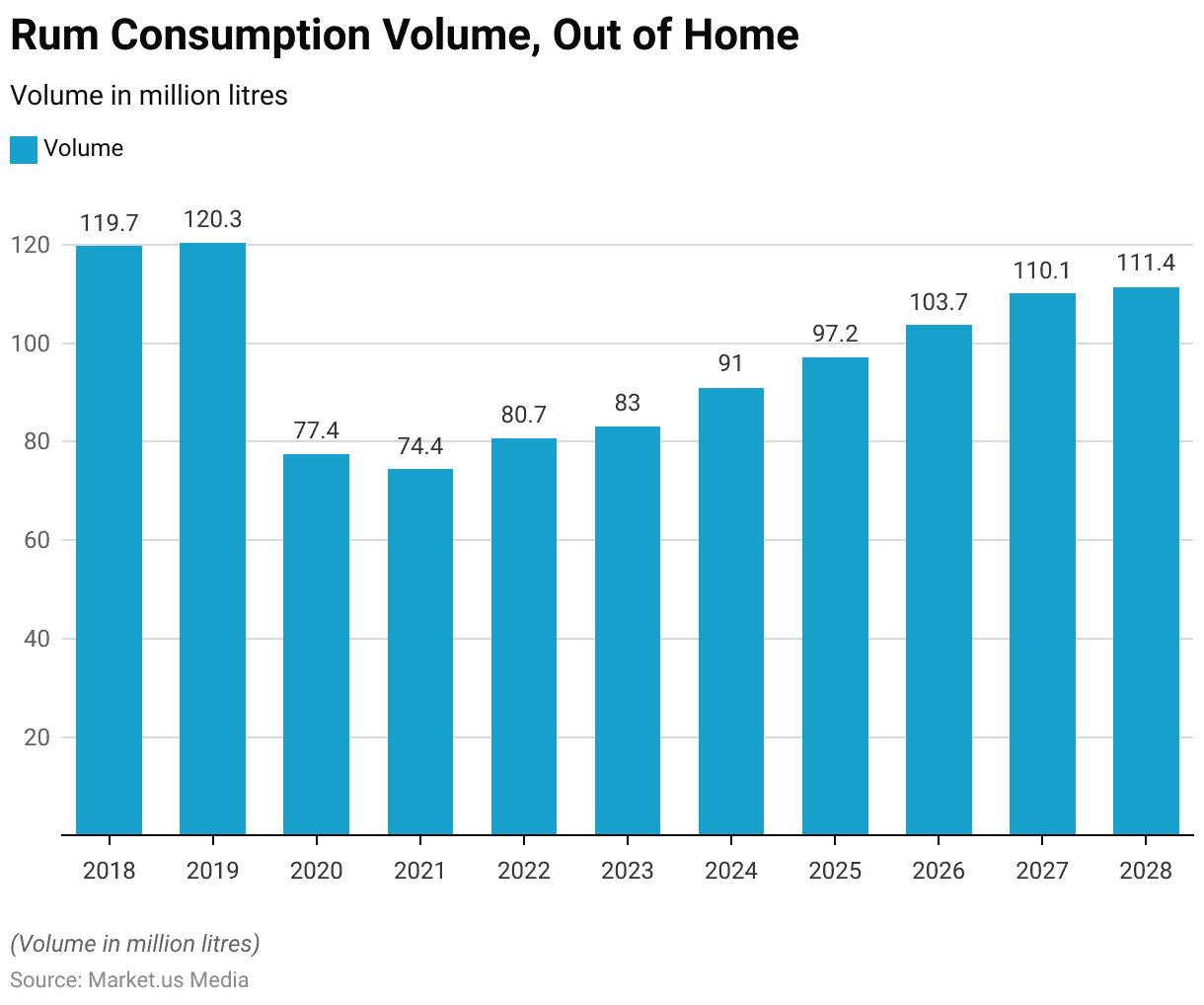
Change in Consumption Value at Home
- The change in rum consumption value at home has experienced various shifts over recent years.
- In 2019, there was a slight decline of 0.3%.
- The most significant drop occurred in 2022, with a reduction of 3.6%.
- However, the market stabilized in 2023, showing no change in consumption value.
- This upward trend is anticipated to persist, albeit at a slower pace, with projected increases of 0.4% in 2025, 0.8% in 2026, 0.7% in 2027, and 1.1% in 2028.
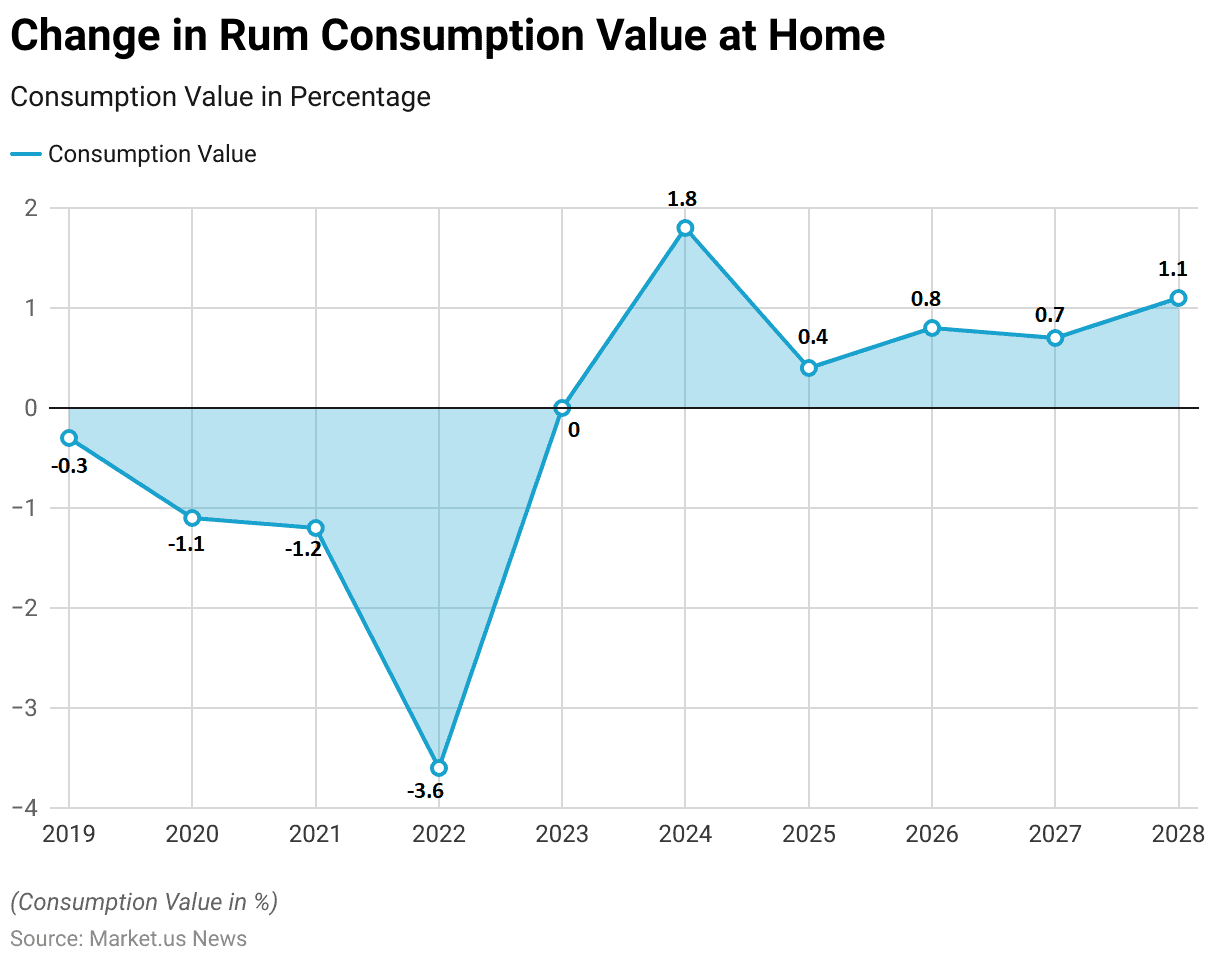
Prices
Overall Price
- The overall price of rum has exhibited significant fluctuations and a general upward trend over the past decade.
- In 2018, the price of rum was USD 15.84, slightly decreasing to USD 15.73 in 2019.
- The year 2020 saw a notable decline to USD 14.47, likely influenced by market disruptions during the COVID-19 pandemic.
- However, a recovery was evident in 2021, with prices rising to USD 15.35.
- Further increases are anticipated, with the price projected to be USD 20.14 in 2027 and USD 20.38 in 2028.

Leading Brands Worldwide – Based On Sales Volume
- In 2022, the leading rum brands worldwide, based on sales volume, demonstrated significant market presence.
- Tanduay led the market with an impressive sales volume of 27.5 million 9-liter cases.
- Bacardi followed with 21.1 million 9-liter cases, and Captain Morgan secured the third position with 12.9 million 9-liter cases.
- McDowell’s No.1 Celebration also showed substantial sales, reaching 8.8 million 9-liter cases.
- Havana Club reported a sales volume of 4.6 million 9-liter cases, while Barcelo achieved 2.7 million 9-liter cases.
- Other notable brands included Contessa, with 1.3 million 9-liter cases, Appleton Jamaica, with 1.1 million 9-liter cases, and Montilla, with 1 million 9-liter cases.

Top Nations Exporting Rum and Tafia
- In 2022, Italy led the global rum export market with a total export value of USD 226 million, accounting for 11.20% of the market.
- The United States followed, exporting rum worth USD 199 million, representing 9.88% of the total exports.
- The Dominican Republic held a significant share, with exports valued at USD 162 million, or 8.05%.
- The Netherlands and France contributed USD 127 million (6.31%) and USD 124 million (6.15%) respectively.
- Spain’s rum exports amounted to USD 119 million, making up 5.19% of the market, while Venezuela exported USD 103 million worth of rum, representing 5.13%.
- Cuba and Guatemala also had notable export values, with USD 90.5 million (4.50%) and USD 89.1 million (4.43%) respectively.

Top Nations Importing Rum and Tafia
- In 2022, Germany was the leading importer of rum, with an import value of USD 177 million, accounting for 8.81% of the global market.
- The United States closely followed, importing rum worth USD 173 million, representing 8.62% of the market.
- Spain also had a significant share, with imports valued at USD 164 million, or 8.13%.
- The United Kingdom imported USD 144 million worth of rum, making up 7.14% of the total imports.
- The Netherlands and Italy contributed USD 127 million (6.13%) and USD 125 million (6.19%) respectively.
- Canada imported USD 110 million worth of rum, which constituted 5.49% of the market, while France’s imports were valued at USD 93.9 million (4.67%).
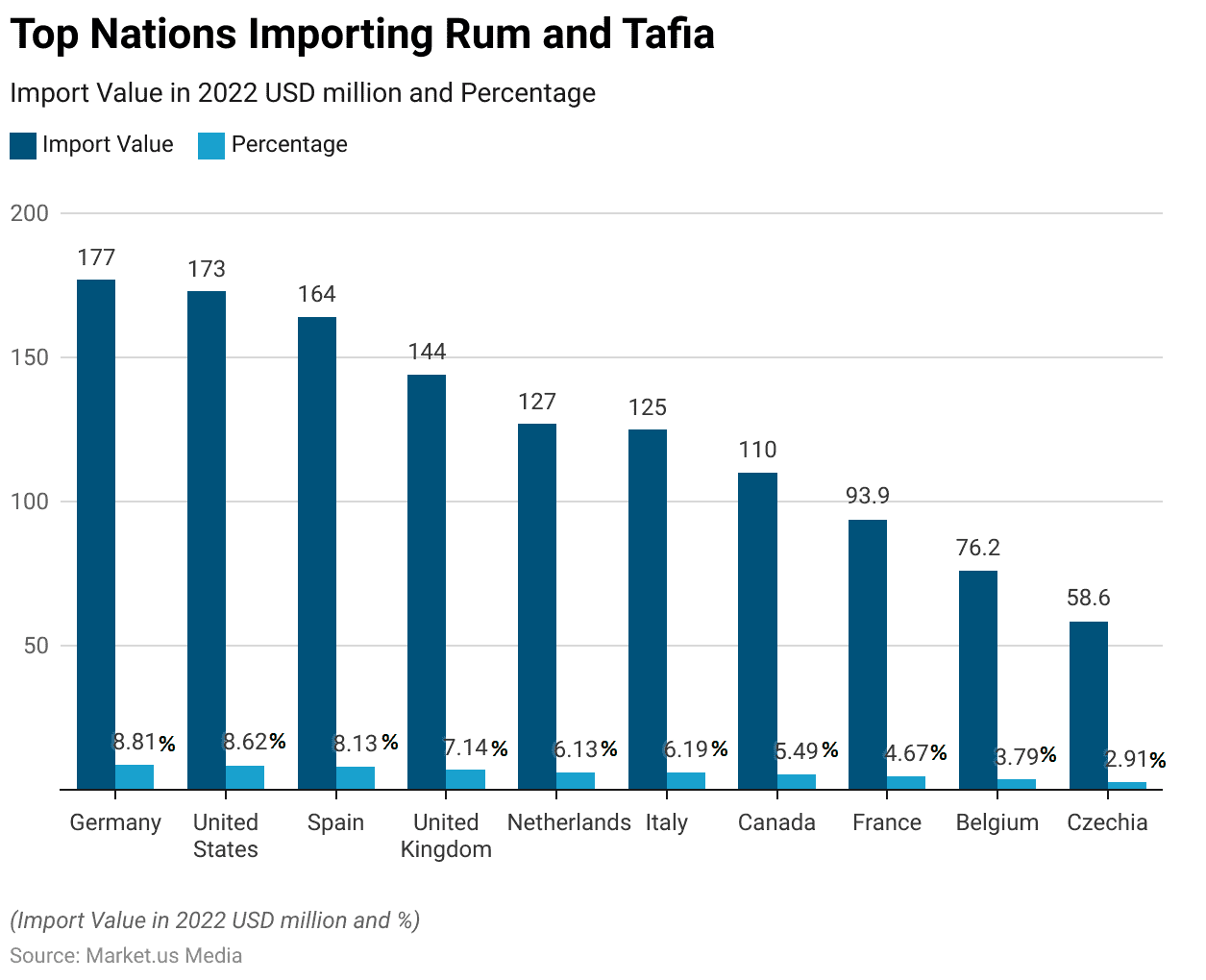
Consumer Preferences for Rum
- Consumer preferences for rum have shifted notably in recent years, with a growing interest in premium and craft varieties.
- In 2022, dark and golden rums dominated the market, accounting for 45.7% of the revenue due to their extended aging process and rich flavor profiles.
- Millennials and Gen Z consumers are particularly drawn to authentic and sustainably produced rums, valuing brands that demonstrate environmental and social responsibility.
Regulations for Rum
- Regulations for rum vary significantly across different countries, reflecting the diverse legal and cultural attitudes towards this craft spirit.
- In the United States, rum regulations focus primarily on the base ingredients, with less stringent geographic protections compared to other spirits like cognac or bourbon. Puerto Rico, however, mandates that even white rum must be aged for at least one year and distilled at 189 proof.
- In the Caribbean, the West Indies Rum & Spirits Producers Association has established the Authentic Caribbean Rum (ACR) mark, which includes tiers based on base materials and age statements, to ensure quality and authenticity.
- In the European Union, regulations require clear labeling of alcohol content and prohibit misleading age statements, aiming to protect consumers and ensure transparency.
Discuss your needs with our analyst
Please share your requirements with more details so our analyst can check if they can solve your problem(s)



